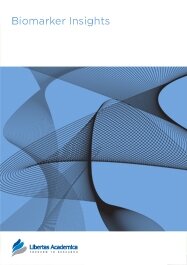

Publication Date: 29 May 2011
Type: Original Research
Journal: Biomarker Insights
Citation: Biomarker Insights 2011:6 59-68
doi: 10.4137/BMI.S7204

Introduction: Concentrations of the total pool of fibronectin in plasma (TFN), and the subset of this pool that contains the alternatively spliced EDA segment (A+FN), are both affected by disease processes, and the latter pool has gained a reputation as a biomarker for vascular injury. We therefore wished to determine if changes in either FN pool correlate with clinical outcomes in critically ill individuals.
Methods: We analyzed a database for 57 patients with major trauma (n = 33) or sepsis syndrome (n = 24) in which plasma levels of TFN and A+FN had been measured at intervals, along with clinical parameters. Logistic regression analysis was performed to detect associations between predictive variables and three clinical outcomes: 1) the acute respiratory distress syndrome (ARDS), 2) milder acute lung injury designated acute hypoxemic respiratory failure (AHRF), and 3) survival to hospital discharge.
Results: An increase in plasma TFN during the first 24 hours of intensive care unit (ICU) observation was negatively associated with progression to ARDS (odds ratio 0.98 per 1 microgram (µg)/ml increase, 95% CI (0.97, 1.00)) and AHRF (OR 0.97 per 1 µg/ml increase, (0.95, 0.99)), whereas an increase in A+FN over the first 24 hours was positively associated with progression to AHRF (OR 1.65 per 1 µg/ml increase, (1.04, 2.62)). Additionally, the ratio of the partial pressure of oxygen in arterial blood (PaO2) to the percentage of oxygen in inspired air (FIO2) after 24 hours was positively associated with survival (OR 1.01 per 1 unit increase in ratio, (1.00, 1.03)), along with change in A+FN (OR 1.30 per 1 µg/ml increase, (0.90, 1.88)).
Conclusions: Different FN isoforms may constitute predictive covariate markers for distinct clinical outcomes in critically ill patients. The data also suggest that early TFN accumulation in the circulation may confer a clinical benefit to patients at risk for acute lung injury.
PDF (569.75 KB PDF FORMAT)
RIS citation (ENDNOTE, REFERENCE MANAGER, PROCITE, REFWORKS)
BibTex citation (BIBDESK, LATEX)
XML
PMC HTML


I have had a great experience with submitting my cancer prognosis study to Biomarker Insights. The comments from reviewers and associate editor are high quality and insightful. Congratulations and keep up the good work.

All authors are surveyed after their articles are published. Authors are asked to rate their experience in a variety of areas, and their responses help us to monitor our performance. Presented here are their responses in some key areas. No 'poor' or 'very poor' responses were received; these are represented in the 'other' category.See Our Results
Copyright © 2013 Libertas Academica Ltd (except open access articles and accompanying metadata and supplementary files.)
Facebook Google+ Twitter
Pinterest Tumblr YouTube